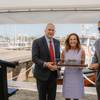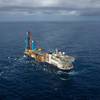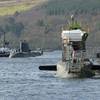Technology: DPS: Expanding Options for Many Operators
Paul English, sales and business development manager for Alstom's Marine and Offshore activities, looks back at the company's role in the development of Dynamic Positioning Systems.
In recent years, dynamic positioning (DP) systems have become almost as accepted a feature of certain types of marine and offshore vessels as autopilot. DP — which automatically controls a ship's heading and station keeping (either a fixed or moving target) while minimizing thruster activity — has considerably expanded the options for shipowners/operators whose vessels remain at sea for long periods of time, often in deep water and in areas where laying anchors is either not an option due to seabed structures, or impractical because of timescales.
These include drill ships, shuttle tankers, FPSOs (floating, production, storage and off-loading), cable ships and pipe layers, offshore support and platform supply vessels, anchor handlers, diving and semi-submersible support vessels and many more.
Increasingly DP is becoming more common in cruise ships, enabling them to keep station in locations where anchoring could result in environmental damage to coral reefs. Alstom has been at the forefront of DP technology for offshore vessels for more than 30 years.
Before then, control of the thrusters was very much a manual process, using only manual controls or the vessel's joystick to keep station — a procedure which challenged the most experienced of captains in changing weather conditions.
Alstom's involvement in vessel control began with the development of the first U.K.-built and owned DP system for the coring and surveying vessel Wimpey Sealab (now Norskald).
A 'stay-still' solution was needed for the vessel, which was to be used for surveying coal deposits off the north east coast of England. The then GEC spent three years developing its first Simplex (stand alone) DP control system, which was purpose-designed for Wimpey Sealab.
GEC followed this in the mid 1970s with a Duplex system for Uncle John, a semi-submersible and diver support vessel. This order marked a significant technical challenge beyond the Wimpey Sealab installation as the thruster configuration was more complex and required a redundant console (one in control with one serving as a hot back up) — to control the vessel.
Development continued through the rest of the 1970s and 1980s with each system being application driven and designed as a one-off to meet the clients' specific needs.
In the 1980s Alstom developed the DPS 800 series, a series, which helped to establish the company's reputation in DP technology. Its key features were retained and further developed as the key attributes for its successor, the 900 series.
Alstom's flagship family of DP control systems is currently the 'A' series, which is suitable for approval by Lloyd, DNV, ABS, Bureau Veritas, Germanischer Lloyds and other classification society standards.
Kalman Filters
Since the early 1980s Alstom's DP technology has been based on Kalman Filters — a mathematical model of the ship and any external forces that affect it, including wind, waves, currents and other forces such as cable and pipe tensions. The information is checked against actual measurements from the vessel's sensors and position measurement systems.
The DP system uses the Kalman filter model to calculate the thruster references, leading to reduced noise and less lag compared to a conventional software filter. Positioning can be maintained over a greater range of weather conditions, enabling the vessel to extend its operational window.
Other advances which have aided the on-going development of DP — and hence more accuracy in vessel positioning — have included developments in measuring equipment. The introduction of Differential GPS, approximately 10 years ago, revolutionized the whole process. The accuracy of global positioning systems - the satellite based passive ranging navigation system which provides latitude, longitude and altitude data for anywhere in the world — had been greatly enhanced with differential GPS which improved standard positioning service (SPS) accuracy for non-military users from 3 - 16 ft. (1 - 5 m).
Most vessels are now fitted with DGPS as standard as it is a cost-effective, widely available solution and, more importantly, makes dynamic positioning a viable proposition for many more vessels. Previously, more expensive positioning systems made the cost of DP prohibitive.
Alstom further enhanced the technology with the development and launch in 2001 of CyScan — a laser-based positioning and tracking system. This high precision system provides another means of independent measurement when standing by other vessels and has advantages over DGPS, which can be affected by interference from the sun's radiation and other factors, knocking it out for short periods of time.
CyScan — evolved from well-established laser-based navigation technologies for industrial applications — provides continuous position feedback to the vessel's DP system and/or to the operator display panel. Unlike other systems, CyScan ensures that the retro-reflective targets are continuously tracked, even in low sun conditions or when bright lights are positioned behind the targets. CyScan even has the ability to identify false targets, such as people wearing reflective clothing.
In recent years the advent of DGPS, combined with the competitiveness and operating advantages of DP systems, has seen a surge in the number of offshore vessels opting for dynamic positioning.
Size is not an issue when it comes to installing DP systems in vessels. Alstom is installing an integrated DP system from its 'A' series in Cunard Line's Queen Mary 2, which will be the largest cruise liner ever built. In contrast, the company has recently commissioned the DP systems for 49 ft. (15-m) catamarans, which need to maintain station for survey work.
Dynamic positioning is suited for nearly all types of vessels — newbuilds or retrofits — with either mechanical (diesel and turbine) or electrical propulsion systems.
The Future
In recent years progress in DP has been concentrated on refining existing equipment: better user interfaces, improved technology and less operator intervention.
Alstom — which has delivered more than 300 DP systems worldwide in the last 30 years — predicts the future will see more integration of systems with other elements of vessel control running on common platforms. The company already has extensive experience in providing fully integrated power and propulsion packages for a wide range of customers and the order book is set to increase as more owner/operators look to single source suppliers to provide total solutions for their power, control and monitoring systems.
Recent Orders
• Bender Shipbuilding & Repair Mobile, Ala., awarded Alstom a $20 million contract to design, install and commission the fully integrated AC electrical propulsion and control systems for 10 new platform supply vessels which will be based in the Gulf of Mexico. The equipment includes DP systems from Alstom's 'A' Series.
• Alstom recently secured a contract to supply its eighth vessel set, each including Simplex DP systems from its 'A' series from the Scheepswerf de Hoop shipyards in the Netherlands and the U.S.. The latest order is for an offshore support vessel for Otto Candies.
• The India-based ABG shipyard has chosen Alstom to supply the complete power and propulsion package for a new generation diesel electric dynamically positioned diving support vessel being built by Consolidated Contractors International SAL (CCC), based in Abu Dhabi.
• In the last year, Singapore-based Swire Pacific Offshore, which maintains a large fleet of vessels for the offshore market, has contracted Alstom to supply DP systems for a total of 12 vessels, built to UT design at shipyards in Norway, Korea and Singapore. This will bring the total number of vessels owned by Swire with Alstom DP systems to more than 20.
Rolls-Royce Makes Next-Generation DPS Strides
Rolls-Royce signaled that it is quickly moving ahead with its mandate to become an integrated, one-stop-shop single source ships system supplier with the announcement that it is working towards developing a next-generation Dynamic Positioning System (DPS). Gunnar Nyland, Rolls-Royce Corporate Research, would not commit to a timetable, but in a discussion recently with Maritime Reporter, he spoke of Rolls-Royce's development plans for its own DP technology to interface, among other things, with GPS and the various proprietary position reference systems. The move is to fulfill the aforementioned single-source strategy, but is also the result of information gathered that indicates bought-in DPS may not be optimized for Rolls-Royce thruster characteristics, resulting in faster equipment wear and higher fuel burn rates. Work is progressing on a Common Control Platform that will align hardware and software solutions and serve as the basis for the RR standard solution, which will target Offshore Service Vessels, rigs, production storage units, and seismic survey vessels, among others. In conjunction, the company is said to be in discussions with a major Integrated Bridge System manufacturer, with an agreement — in whatever form it takes — allowing RR to take yet another major step toward its single-source goal. The DPS solution will offer everything from standard systems to complex technical solutions, ranging from single IMO DP Class 1 class systems to sophisticated redundant systems meeting the IMO DP Class 2 and 3 requirements. The company will take a module-based approach for both the software and hardware components, a strategy to increase flexibility for the user and enable easier system upgrades.












